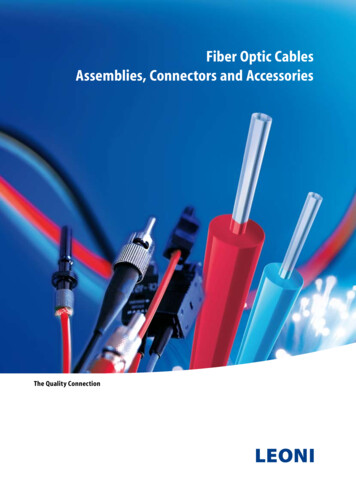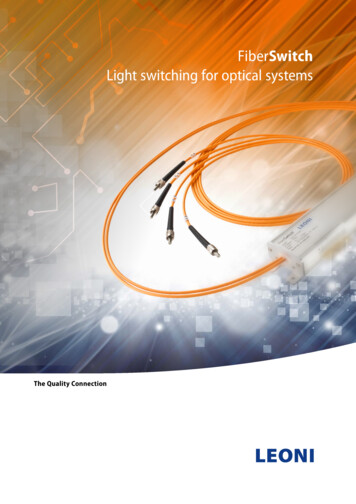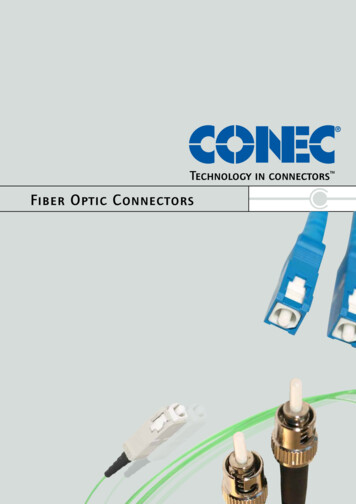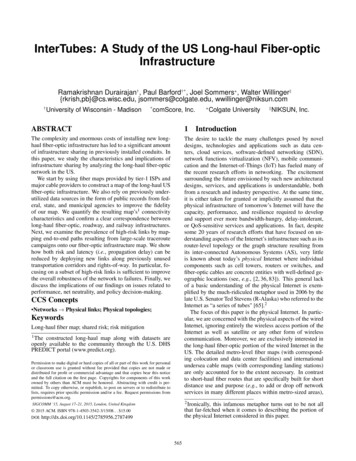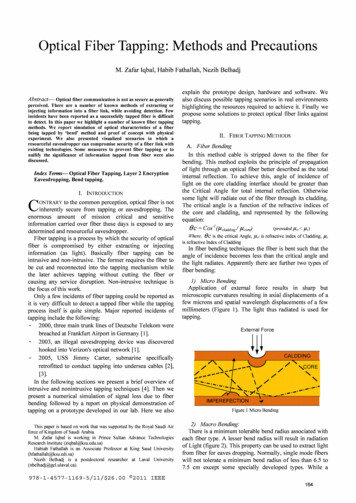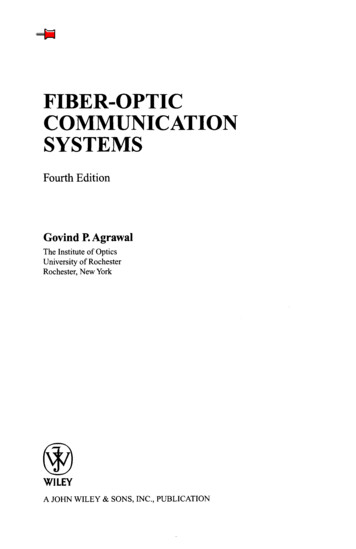
Transcription
FIBER-OPTICCOMMUNICATIONSYSTEMSFourth EditionGovind P. AgrawalThe Institute of OpticsUniversity of RochesterRochester, New YorkWILEYA JOHN WILEY & SONS, INC., PUBLICATION
This page intentionally left blank
FIBER-OPTICCOMMUNICATIONSYSTEMS
WILEY SERIES IN MICROWAVE AND OPTICAL ENGINEERINGKAI CHANG, EditorTexas A&M UniversityA complete list of the titles in this series appears at the end of this volume.
FIBER-OPTICCOMMUNICATIONSYSTEMSFourth EditionGovind P. AgrawalThe Institute of OpticsUniversity of RochesterRochester, New YorkWILEYA JOHN WILEY & SONS, INC., PUBLICATION
Copyright 2010 by John Wiley & Sons, Inc. All rights reserved.Published by John Wiley & Sons, Inc., Hoboken, New Jersey.Published simultaneously in Canada.No part of this publication may be reproduced, stored in a retrieval system, or transmitted in any form orby any means, electronic, mechanical, photocopying, recording, scanning, or otherwise, except as permitted under Section 107 or 108 of the 1976 United States Copyright Act, without either the prior writtenpermission of the Publisher, or authorization through payment of the appropriate per-copy fee to theCopyright Clearance Center, Inc., 222 Rosewood Drive, Danvers, MA 01923, (978) 750-8400, fax (978)750-4470, or on the web at www.copyright.com. Requests to the Publisher for permission should be addressed to the Permissions Department, John Wiley & Sons, Inc., 111 River Street, Hoboken, NJ 07030,(201) 748-6011, fax (201) 748-6008, or online at http://www.wiley.com/go/permission.Limit of Liability/Disclaimer of Warranty: While the publisher and author have used their best efforts inpreparing this book, they make no representations or warranties with respect to the accuracy or completeness of the contents of this book and specifically disclaim any implied warranties of merchantability or fitness for a particular purpose. No warranty may be created or extended by sales representatives orwritten sales materials. The advice and strategies contained herein may not be suitable for your situation.You should consult with a professional where appropriate. Neither the publisher nor author shall be liable for any loss of profit or any other commercial damages, including but not limited to special, incidental, consequential, or other damages.For general information on our other products and services or for technical support, please contact ourCustomer Care Department within the United States at (800) 762-2974, outside the United States at(317) 572-3993 or fax (317) 572-4002.Wiley also publishes its books in a variety of electronic formats. Some content that appears in print maynot be available in electronic formats. For more information about Wiley products, visit our web site atwww.wiley.com.Library of Congress Cataloging-in-Publication Data:Agrawal, G. P. (Govind P.), 1951Fiber-optic communication systems with cd / Govind P. Agrawal. — 4th ed.p. cm. — (Wiley series in microwave and optical engineering ; 222)ISBN 978-0-470-50511-3 (hardback)1. Optical communications. 2. Fiber optics. I. Title.TK5103.59.A37 2010621.38275—dc222010023284Printed in the United States of America.10 9 8 7 6 5 4 3 2 1
To the memory of my ParentsTo Anne, Sipra, Caroline, and Claire
This page intentionally left blank
ContentsPrefacexv1Introduction1.1 Historical Perspective1.1.1 Need for Fiber-Optic Communications1.1.2 Evolution of Lightwave Systems1.2 Basic Concepts1.2.1 Analog and Digital Signals1.2.2 Channel Multiplexing1.2.3 Modulation Formats1.3 Optical Communication Systems1.4 Lightwave System Components1.4.1 Optical Fibers as a Communication Channel1.4.2 Optical Transmitters1.4.3 Optical 12Optical Fibers2.1 Geometrical-Optics Description2.1.1 Step-Index Fibers2.1.2 Graded-Index Fibers2.2 Wave Propagation2.2.1 Maxwell's Equations2.2.2 Fiber Modes2.2.3 Single-Mode Fibers2.3 Dispersion in Single-Mode Fibers2.3.1 Group-Velocity Dispersion2.3.2 Material Dispersion2.3.3 Waveguide Dispersion2.3.4 Higher-Order Dispersion2.3.5 Polarization-Mode Dispersion2.4 Dispersion-Induced Limitations2.4.1 Basic Propagation Equation24242527292931343839404143444646vii
ContentsVili2.4.2 Chirped Gaussian Pulses2.4.3 Limitations on the Bit Rate2.4.4 Fiber Bandwidth2.5 Fiber Losses2.5.1 Attenuation Coefficient2.5.2 Material Absorption2.5.3 Rayleigh Scattering2.5.4 Waveguide Imperfections2.6 Nonlinear Optical Effects2.6.1 Stimulated Light Scattering2.6.2 Nonlinear Phase Modulation2.6.3 Four-Wave Mixing2.7 Fiber Design and Fabrication2.7.1 Silica Fibers2.7.2 Plastic Optical Fibers2.7.3 Cables and ConnectorsProblemsReferences3Optical Transmitters3.1 Semiconductor Laser Physics3.1.1 Spontaneous and Stimulated Emissions3.1.2 Nonradiative Recombination3.1.3 Optical Gain3.1.4 Feedback and Laser Threshold3.1.5 Longitudinal Modes3.1.6 Laser Structures3.2 Single-Mode Semiconductor Lasers3.2.1 Distributed Feedback Lasers3.2.2 Coupled-Cavity Semiconductor Lasers3.2.3 Tunable Semiconductor Lasers3.2.4 Vertical-Cavity Surface-Emitting Lasers3.3 Laser Characteristics3.3.1 CW Characteristics3.3.2 Modulation Bandwidth3.3.3 Relative Intensity Noise3.3.4 Spectral Linewidth3.4 Optical Signal Generation3.4.1 Direct Modulation3.4.2 External Modulation3.5 Light-Emitting Diodes3.5.1 CW Characteristics3.5.2 Modulation Response3.5.3 LED Structures3.6 Transmitter Design3.6.1 Source-Fiber 113115115
Contents3.6.23.6.3ProblemsReferencesixDriving CircuitryReliability and Packaging1181191211224Optical Receivers4.1 Basic Concepts4.1.1 Responsivity and Quantum Efficiency4.1.2 Rise Time and Bandwidth4.2 Common Photodetectors4.2.1 p-n Photodiodes4.2.2 p-i-n Photodiodes4.2.3 Avalanche Photodiodes4.2.4 MSM Photodetectors4.3 Receiver Design4.3.1 Front End4.3.2 Linear Channel4.3.3 Decision Circuit4.3.4 Integrated Receivers4.4 Receiver Noise4.4.1 Noise Mechanisms4.4.2 p-i-n Receivers4.4.3 APD Receivers4.5 Coherent Detection4.5.1 Local Oscillator4.5.2 Homodyne Detection4.5.3 Heterodyne Detection4.5.4 Signal-to-Noise Ratio4.6 Receiver Sensitivity4.6.1 Bit-Error Rate4.6.2 Minimum Received Power4.6.3 Quantum Limit of Photodetection4.7 Sensitivity Degradation4.7.1 Extinction Ratio4.7.2 Intensity Noise4.7.3 Timing Jitter4.8 Receiver 11621641661671671691711731751775Lightwave Systems5.1 System Architectures5.1.1 Point-to-Point Links5.1.2 Distribution Networks5.1.3 Local-Area Networks5.2 Design Guidelines182182182184185187
Contentsx65.2.1 Loss-Limited Lightwave Systems5.2.2 Dispersion-Limited Lightwave Systems5.2.3 Power Budget5.2.4 Rise-Time Budget5.3 Long-Haul Systems5.3.1 Performance-Limiting Factors5.3.2 Terrestrial Lightwave Systems5.3.3 Undersea Lightwave Systems5.4 Sources of Power Penalty5.4.1 Modal Noise5.4.2 Mode-Partition Noise5.4.3 Reflection Feedback and Noise5.4.4 Dispersive Pulse Broadening5.4.5 Frequency Chirping5.4.6 Eye-Closure Penalty5.5 Forward Error Correction5.5.1 Error-Correcting Codes5.5.2 Coding Gain5.6 Computer-Aided 0201202204208209210212212213214216218Multichannel Systems6.1 WDM Lightwave Systems6.1.1 High-Capacity Point-to-Point Links6.1.2 Wide-Area and Metro-Area Networks6.1.3 Multiple-Access WDM Networks6.2 WDM Components6.2.1 Tunable Optical Filters6.2.2 Multiplexers and Demultiplexers6.2.3 Add-Drop Multiplexers and Filters6.2.4 Star Couplers6.2.5 Wavelength Routers6.2.6 WDM Transmitters and Receivers6.3 System Performance Issues6.3.1 Heterowavelength Linear Crosstalk6.3.2 Homowavelength Linear Crosstalk6.3.3 Nonlinear Raman Crosstalk6.3.4 Stimulated Brillouin Scattering6.3.5 Cross-Phase Modulation6.3.6 Four-Wave Mixing6.3.7 Other Design Issues6.4 Time-Division Multiplexing6.4.1 Channel Multiplexing6.4.2 Channel Demultiplexing6.4.3 System 251253255257259261262264264266268
Contents7xi6.5Subcarrier Multiplexing6.5.1 Analog and Digital SCM Systems6.5.2 Multiwavelength SCM Systems6.5.3 Orthogonal Frequency-Division multiplexing6.6 Code-Division Multiplexing6.6.1 Time-Domain Encoding6.6.2 Frequency-Domain Encoding6.6.3 Frequency 83285Loss Management7.1 Compensation of Fiber Losses7.1.1 Periodic Amplification Scheme7.1.2 Lumped Versus Distributed Amplification7.1.3 Bidirectional Pumping Scheme7.2 Erbium-Doped Fiber Amplifiers7.2.1 Pumping and Gain Spectrum7.2.2 Two-Level Model7.2.3 Amplifier Noise7.2.4 Multichannel Amplification7.3 Raman Amplifiers7.3.1 Raman Gain and Bandwidth7.3.2 Raman-Induced Signal Gain7.3.3 Multiple-Pump Raman Amplification7.3.4 Noise Figure of Raman Amplifiers7.4 Optical Signal-To-Noise Ratio7.4.1 Lumped Amplification7.4.2 Distributed Amplification7.5 Electrical Signal-To-Noise Ratio7.5.1 ASE-Induced Current Fluctuations7.5.2 Impact of ASE on SNR7.5.3 Noise Buildup in an Amplifier Chain7.6 Receiver Sensitivity and Q Factor7.6.1 Bit-Error Rate7.6.2 Relation between Q Factor and Optical SNR7.7 Role of Dispersive and Nonlinear Effects7.7.1 Noise Growth through Modulation Instability7.7.2 Noise-Induced Signal Degradation7.7.3 Noise-Induced Energy Fluctuations7.7.4 Noise-Induced Timing Jitter7.8 Periodically Amplified Lightwave Systems7.8.1 Numerical Approach7.8.2 Optimum Launched 8328330332333334335337339340
ContentsDispersion Management8.1 Dispersion Problem and Its Solution8.2 Dispersion-Compensating Fibers8.2.1 Conditions for Dispersion Compensation8.2.2 Dispersion Maps8.2.3 DCF Designs8.3 Fiber Bragg Gratings8.3.1 Constant-Period Gratings8.3.2 Chirped Fiber Gratings8.3.3 Sampled Gratings8.4 Dispersion-Equalizing Filters8.4.1 Gires-Tournois Filters8.4.2 Mach-Zehnder Filters8.4.3 Other All-Pass Filters8.5 Optical Phase Conjugation8.5.1 Principle of Operation8.5.2 Compensation of Self-Phase Modulation8.5.3 Generation of Phase-Conjugated Signal8.6 Channels at High Bit Rates8.6.1 Tunable Dispersion Compensation8.6.2 Higher-Order Dispersion Management8.6.3 PMD Compensation8.7 Electronic Dispersion Compensation8.7.1 Basic Idea behind GVD Precompensation8.7.2 Precompensation at the Transmitter8.7.3 Dispersion Compensation at the 6392397399Control of Nonlinear Effects9.1 Impact of Fiber Nonlinearity9.1.1 System Design Issues9.1.2 Semianalytic Approach9.1.3 Soliton and Pseudo-linear Regimes9.2 Solitons in Optical Fibers9.2.1 Properties of Optical Solitons9.2.2 Loss-Managed Solitons9.3 Dispersion-Managed Solitons9.3.1 Dispersion-Decreasing Fibers9.3.2 Periodic Dispersion Maps9.3.3 Design Issues9.3.4 Timing Jitter9.3.5 Control of Timing Jitter9.4 Pseudo-linear Lightwave Systems9.4.1 Origin of Intrachannel Nonlinear Effects9.4.2 Intrachannel Cross-Phase 32434435437
Contents9.4.3 Intrachannel Four-Wave MixingControl of Intrachannel Nonlinear Effects9.5.1 Optimization of Dispersion Maps9.5.2 Phase-Alternation Techniques9.5.3 Polarization Bit InterleavingProblemsReferences9.510 Advanced Lightwave Systems10.1 Advanced Modulation Formats10.1.1 Encoding of Optical Signals10.1.2 Amplitude and Phase Modulators10.2 Demodulation Schemes10.2.1 Synchronous Heterodyne Demodulation10.2.2 Asynchronous Heterodyne Demodulation10.2.3 Optical Delay Demodulation10.3 Shot Noise and Bit-Error Rate10.3.1 Synchronous Heterodyne Receivers10.3.2 Asynchronous Heterodyne Receivers10.3.3 Receivers with Delay Demodulation10.4 Sensitivity Degradation Mechanisms10.4.1 Intensity Noise of Lasers10.4.2 Phase Noise of Lasers10.4.3 Signal Polarization Fluctuations10.4.4 Noise Added by Optical Amplifiers10.4.5 Fiber Dispersion10.5 Impact of Nonlinear Effects10.5.1 Nonlinear Phase Noise10.5.2 Effect of Fiber Dispersion10.5.3 Compensation of Nonlinear Phase Noise10.6 Recent Progress10.6.1 Systems with the DBPSK format10.6.2 Systems with the DQPSK format10.6.3 QAM and Related formats10.6.4 Systems Employing Orthogonal FDM10.7 Ultimate Channel 8348448548648949049449449649749950150350411 Optical Signal Processing51111.1 Nonlinear Techniques and Devices51111.1.1 Nonlinear Optical Loop Mirrors51211.1.2 Parametric Amplifiers51611.1.3 Nonlinear Effects in Semiconductor Optical Amplifiers . . . . 52211.1.4 Bistable Optical Devices52611.2 All-Optical Flip-Flops529
ContentsXIV11.2.1 Semiconductor Lasers and SOAs11.2.2 Coupled Semiconductor Lasers and SOAs11.3 Wavelength Converters11.3.1 XPM-Based Wavelength Converters11.3.2 FWM-Based Wavelength Converters11.3.3 Passive Semiconductor Waveguides11.3.4 SOA-Based Wavelength Converters11.4 Ultrafast Optical Switching11.4.1 Time-Domain Demultiplexing11.4.2 Data-Format Conversion11.4.3 Packet Switching11.5 Optical Regenerators11.5.1 Fiber-Based 2R Regenerators11.5.2 SOA-Based 2R Regenerators11.5.3 Fiber-Based 3R Regenerators11.5.4 SOA-Based 3R Regenerators11.5.5 Regeneration of Phase-Encoded 45549552553553559560562565568569A System of Units578B Acronyms580C General Formula for Pulse Broadening584D Software Package587Index589
PrefaceSince the publication of the first edition of this book in 1992, the state of the art offiber-optic communication systems has advanced dramatically despite the relativelyshort period of only 18 years between the first and fourth editions. The highest capacity of commercial fiber-optic links available in 1992 was only 2.5 Gb/s. A mere 4years later, with the advent of wavelength-division multiplexing (WDM), systems withthe total capacity of 40 Gb/s became available commercially. By 2001, the capacityof commercial WDM systems exceeded 1.6 Tb/s. At the same time, the capacity oftransoceanic lightwave systems installed worldwide exploded. A global network covering 250,000 km with a capacity of 2.56 Tb/s (64 WDM channels at 10 Gb/s over 4fiber pairs) was planned in 2001 and became operational by 2004 (currently operated byVSNL, an Indian telecommunication company). Although the pace slowed down after2001 for a few years with the bursting of the so-called "telecom bubble," progress in thedesign of lightwave systems continued and accelerated after 2006 with the advent ofphase-based modulation formats, 100-Gb Ethernet, and orthogonal frequency-divisionmultiplexing.The third edition of this book appeared in 2002. It has been well received by thescientific community involved with lightwave technology as well as by the educationalcommunity, judging from book's adoption as a textbook for courses offered at manyuniversities worldwide. Because of the rapid advances that have occurred over thelast 8 years, the publisher and I deemed it necessary to bring out the fourth edition ifthe book were to continue to provide a comprehensive and up-to-date account of fiberoptic communication systems. The result is in your hands. The primary objective of thebook remains the same. Specifically, it should be able to serve both as a textbook and areference monograph. For this reason, the emphasis is on the physical understanding,but the engineering aspects are also discussed throughout the text.Because of the large amount of material that needed to be added to provide comprehensive coverage, the book size has increased considerably compared with the firstedition. Although all chapters have been updated, the major changes have occurredin Chapters 7-11. I have taken this opportunity to rearrange the material such that itis better suited for a two-semester course on optical communications. In particular,the chapter on WDM systems has been moved earlier and now appears as Chapter 6.With this arrangement, Chapters 1 to 6 provide the basic foundation, while Chapters7 to 11 cover the issues related to the design of advanced lightwave systems. Morespecifically, after the introduction of the elementary concepts in Chapter 1, Chapters2-4 are devoted to the three primary components of a fiber-optic communications—xv
XVIPrefaceoptical fibers, optical transmitters, and optical receivers. Chapters 5 and 6 then focuson the design issues relevant for single-channel and multichannel systems, respectively.Chapters 7 and 8 are devoted to the advanced techniques used for the management offiber losses and chromatic dispersion, respectively. Chapter 9 focuses on the impact ofnonlinear effects and techniques used to manage them such as the use of optical solitons and pseudo-linear propagation through enhanced dispersion. Chapters 10 and 11are new to the fourth edition. Chapter 10 focuses primarily on the coherent and selfcoherent lightwave systems making use of the novel phase-based modulation formats.Chapter 11 is devoted to all-optical signal processing with emphasis on wavelengthconversion and optical regeneration. The contents of the book reflect the state of theart of lightwave systems in 2010.The primary role of this book is as a graduate-level textbook in the field of opticalcommunications. An attempt is made to include as much recent material as possibleso that students are exposed to the recent advances in this exciting field. The book canalso serve as a reference text for researchers already engaged in or wishing to enterthe field of optical fiber communications. The reference list at the end of each chapteris more elaborate than what is common for a typical textbook. The listing of recentresearch papers should be useful for researchers using this book as a reference. Atthe same time, students can benefit from it if they are assigned problems requiringreading of the original research papers. A set of problems is included at the end ofeach chapter to help both the teacher and the student. Although written primarily forgraduate students, the book can also be used for an undergraduate course at the seniorlevel with an appropriate selection of topics. Parts of the book can be used for severalother related courses. For example, Chapter 2 can be used for a course on opticalwaveguides, and Chapters 3 and 4 can be useful for a course on optoelectronics.Many universities in the United States and elsewhere offer a course on optical communications as a part of their curriculum in electrical engineering, physics, or optics. Ihave taught such a course since 1989 to the graduate students of the Institute of Optics,and this book indeed grew out of my lecture notes. I am aware that it is used as a textbook by many instructors worldwide—a fact that gives me immense satisfaction. I amacutely aware of a problem that is a side effect of an enlarged revised edition. How cana teacher fit all this material in a one-semester course on optical communications'} Ihave to struggle with the same question. In fact, it is impossible to cover the entire bookin one semester. The best solution is to offer a two-semester course covering ChaptersI through 6 during the first semester, leaving the remainder for the second semester.However, not many universities may have the luxury of offering a two-semester courseon optical communications. The book can be used for a one-semester course providedthat the instructor makes a selection of topics. For example, Chapter 3 can be skippedif the students have taken a laser course previously. If only parts of Chapters 7 throughII are covered to provide students a glimpse of the recent advances, the material canfit in a single one-semester course offered either at the senior level for undergraduatesor to graduate students.The book features a compact disk (CD) on the back cover provided by the OptiwaveCorporation. The CD contains a state-of-the art software package suitable for designingmodern lightwave systems. It also contains additional problems for each chapter thatcan be solved by using the software package. Appendix D provides more details about
Prefacexvnthe software and the problems. It is my hope that the CD will help to train the studentsand will prepare them better for an industrial job.A large number of persons have contributed to this book either directly or indirectly.It is impossible to mention all of them by name. I thank my graduate students and thestudents who took my course on optical communication systems and helped improvemy class notes through their questions and comments. Thanks are due to many instructors who not only have adopted this book as a textbook for their courses but have alsopointed out the misprints in previous editions, and thus have helped me in improvingthe book. I am grateful to my colleagues at the Institute of Optics for numerous discussions and for providing a cordial and productive atmosphere. I appreciated the helpof Karen Rolfe, who typed the first edition of this book and made numerous revisionswith a smile. Last, but not least, I thank my wife, Anne, and my daughters, Sipra,Caroline, and Claire, for understanding why I needed to spend many weekends on thebook instead of spending time with them.Govind P. AgrawalRochester, NYApril 2010
This page intentionally left blank
Chapter 1IntroductionA communication system transmits information from one place to another, whetherseparated by a few kilometers or by transoceanic distances. Information is often carried by an electromagnetic carrier wave whose frequency can vary from a few megahertz to several hundred terahertz. Optical communication systems use high carrierfrequencies ( 100 THz) in the visible or near-infrared region of the electromagneticspectrum. They are sometimes called lightwave systems to distinguish them from microwave systems, whose carrier frequency is typically smaller by five orders of magnitude ( 1 GHz). Fiber-optic communication systems are lightwave systems that employ optical fibers for information transmission. Such systems have been deployedworldwide since 1980 and have revolutionized the field of telecommunications. Indeed, lightwave technology, together with microelectronics, led to the advent of the"information age" during the 1990s. This book describes fiber-optic communicationsystems in a comprehensive manner. The emphasis is on the fundamental aspects, butrelevant engineering issues are also discussed. In this introductory chapter we presentthe basic concepts and provide the background material. Section 1.1 gives a historicalperspective on the development of optical communication systems. Section 1.2 coversconcepts such as analog and digital signals, channel multiplexing, and modulation formats. Relative merits of various lightwave systems are discussed in Section 1.3. Thelast section focuses on the building blocks of a fiber-optic communication system.1.1 Historical PerspectiveThe use of light for communication purposes dates back to antiquity if we interpretoptical communications in a broad sense [1]. Most civilizations have used mirrors, firebeacons, or smoke signals to convey a single piece of information (such as victory ina war). Essentially the same idea was used up to the end of the eighteenth centurythrough signaling lamps, flags, and other semaphore devices. The idea was extendedfurther, following a suggestion of Claude Chappe in 1792, to transmit mechanicallycoded messages over long distances ( 100 km) by the use of intermediate relay stations [2], acting as regenerators or repeaters in the modern-day language. Figure 1.11
2Chapter 1. IntroductionFigure 1.1: Schematic illustration of the optical telegraph and its inventor Claude Chappe. (AfterRef. [2]; 1944 American Association for the Advancement of Science; reprinted with permission.)shows the basic idea schematically. The first such "optical telegraph" was put in servicebetween Paris and Lille (two French cities about 200 km apart) in July 1794. By 1830,the network had expanded throughout Europe [1]. The role of light in such systemswas simply to make the coded signals visible so that they could be intercepted by therelay stations. The opto-mechanical communication systems of the nineteenth centurywere inherently slow. In modern-day terminology, the effective bit rate of such systemswas less than 1 bit per second (B 1 b/s).1.1.1 Need for Fiber-Optic CommunicationsThe advent of telegraphy in the 1830s replaced the use of light by electricity and beganthe era of electrical communications [3]. The bit rate B could be increased to 10 b/sby the use of new coding techniques, such as the Morse code. The use of intermediaterelay stations allowed communication over long distances ( 1000 km). Indeed, thefirst successful transatlantic telegraph cable went into operation in 1866. Telegraphyused essentially a digital scheme through two electrical pulses of different durations(dots and dashes of the Morse code). The invention of the telephone in 1876 broughta major change inasmuch as electric signals were transmitted in analog form through acontinuously varying electric current [4]. Analog electrical techniques were to dominate communication systems for a century or so.The development of worldwide telephone networks during the twentieth centuryled to many advances in the design of electrical communication systems. The useof coaxial cables in place of wire pairs increased system capacity considerably. Thefirst coaxial-cable system, put into service in 1940, was a 3-MHz system capable oftransmitting 300 voice channels or a single television channel. The bandwidth of suchsystems is limited by the frequency-dependent cable losses, which increase rapidly forfrequencies beyond 10 MHz. This limitation led to the development of microwavecommunication systems in which an electromagnetic carrier wave with frequencies inthe range of 1-10 GHz is used to transmit the signal by using suitable modulationtechniques.
1.1. Historical Perspective3"i—i—i—i— —i—i—i—i— —i—i—I—rj—1U/ II 10 1210Optical amplifiers —Lightwave ft9/6ä io/////—/Microwave '—Coaxial cables 10 3.Telephone , y/* 1850"Telegraphi JIIL J1900IYearIII I1950III I2000Figure 1.2: Increase in bit rate-distance product BL during the period 1850-2000. The emergence of a new technology is marked by a solid circle.The first microwave system operating at the carrier frequency of 4 GHz was putinto service in 1948. Since then, both coaxial and microwave systems have evolvedconsiderably and are able to operate at bit rates 100 Wals. The most advanced coaxial system was put into service in 1975 and operated at a bit rate of 274 Mb/s. A severedrawback of such high-speed coaxial systems is their small repeater spacing ( 1 km),which makes the system relatively expensive to operate. Microwave communicationsystems generally allow for a larger repeater spacing, but their bit rate is also limitedby the carrier frequency of such waves. A commonly used figure of merit for communication systems is the bit rate-distance product, BL, where B is the bit rate and L isthe repeater spacing. Figure 1.2 shows how the BL product has increased through technological advances during the last century and a half. Communication systems withBL 100 (Mb/s)-km were available by 1970 and were limited to such values becauseof fundamental limitations.It was realized during the second half of the twentieth century that an increaseof several orders of magnitude in the BL product would be possible if optical waveswere used as the carrier. However, neither a coherent optical source nor a suitabletransmission medium was available during the 1950s. The invention of the laser andits demonstration in 1960 solved the first problem [5]. Attention was then focusedon finding ways for using laser light for optical communications. Many ideas wereadvanced during the 1960s [6], the most noteworthy being the idea of light confinementusing a sequence of gas lenses [7].
4Chapter 1. IntroductionFigure 1.3: Increase in the capacity of lightwave systems realized after 1980. The dotted linesindicate a nearly exponential growth in the bit rate for both the research and commercial systems.Note the change in the slope after 2001.It was suggested in 1966 that optical fibers might be the best choice [8], as theyare capable of guiding the light in a manner similar to the guiding of electrons in copper wires. The main problem was the high losses of optical fibers—fibers availableduring the 1960s had losses in excess of 1000 dB/km. A breakthrough occurred in1970 when fiber losses could be reduced to below 20 dB/km in the wavelength regionnear 1 jum [9]. At about the same time, GaAs semiconductor lasers, operating continuously at room temperature, were demonstrated [10]. The simultaneous availability ofcompact optical sources and a low-loss optical fibers led to a worldwide effort for developing fiber-optic communication systems [11]. Figure 1.3 shows the increase in thecapacity of lightwave systems realized after 1980 through several generations of development [12]. As seen there, the commercial deployment of lightwave systems followedthe research and development phase closely. The progress has indeed been rapid as evident from an increase in the bit rate by a factor of 100,000 over a period of less than 30years. Transmission distances have also increased from 10 to 10,000 km over the sametime period. As a result, the bit rate-distance product of modern lightwave systems canexceed by a factor of 107 compared with the first-generation lightwave systems.1.1.2 Evolution of Lightwave SystemsThe research phase of fiber-optic communication systems started around 1975. Theenormous progress realized over the 25-year period extending from 1975 to 2000 canbe grouped into several distinct generations. Figure 1.4 shows the increase in the BLproduct over this time period as quantified through various laboratory experiments [13].The straight l
1.1.2 Evolution of Lightwave Systems 4 1.2 Basic Concepts 8 1.2.1 Analog and Digital Signals 8 1.2.2 Channel Multiplexing 11 1.2.3 Modulation Formats 13 1.3 Optical Communication Systems 16 1.4 Lightwave System Components 17 1.4.1 Optical Fibers as a Communication Channel 18 1.4.2 Optical Transmitters 18 1.4.3 Optical Receivers 19 Problems 20
